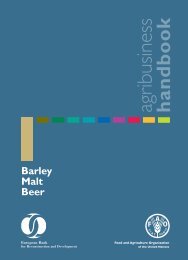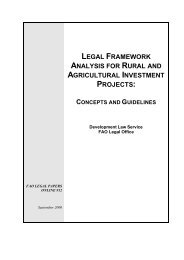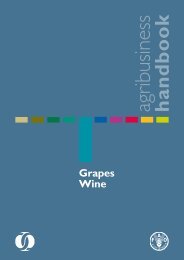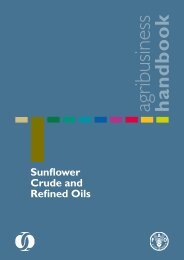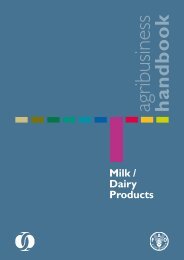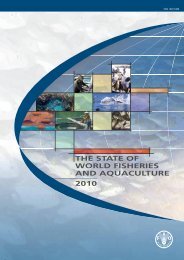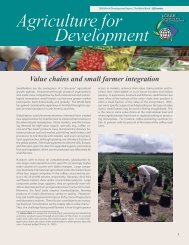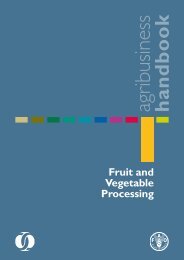Foreign Direct Investment (FDI) in Land in developing countries
Foreign Direct Investment (FDI) in Land in developing countries
Foreign Direct Investment (FDI) in Land in developing countries
- No tags were found...
Create successful ePaper yourself
Turn your PDF publications into a flip-book with our unique Google optimized e-Paper software.
43Legal multi- and bilateral environmentLaos signed 24 BITs. All relevant <strong>FDI</strong> <strong>in</strong> land<strong>in</strong>vest<strong>in</strong>g <strong>countries</strong> are <strong>in</strong>cluded. Laos’ BITs<strong>in</strong>clude compensation for expropriation andmeasures to protect the domestic economy.Legal domestic environmentAccord<strong>in</strong>g to the constitution, land is completelyowned by the state and, therefore, land cannot besold de jure. Nevertheless, the assignment ofpermanent use rights allows the evolution of aland market. Accord<strong>in</strong>g to the <strong>Land</strong> Law 2003,the Lao tenure system is de facto based on stateland and private land, whereas private property,as long as it is not collid<strong>in</strong>g with public <strong>in</strong>terests,is secured by article 16 of the constitution. Additionally,communal land is def<strong>in</strong>ed <strong>in</strong> the Decree88 from 2008, but not yet <strong>in</strong>cluded with<strong>in</strong> the<strong>Land</strong> Law.In rural areas, generally no titles are issued, ma<strong>in</strong>lybecause 99% of the rural areas would not qualifyfor the current requirements that have to be metto receive a title. However, for local villagers atraditional system based on the knowledge of thevillage community can guarantee the use rights aslong as there are no conflict<strong>in</strong>g outside claims. Incases of <strong>FDI</strong> <strong>in</strong> land, the traditional system is notappropriate for sav<strong>in</strong>g the rights of the traditionalowners as these rights are not recognised by thestate. Neither <strong>in</strong>dividual nor common/collectiveuse rights are registered. Hence, the state considersall rural land to be state land which it can allocate<strong>in</strong> form of concessions. S<strong>in</strong>ce 2002, when pressureon land resources <strong>in</strong>creased, caused by the emergenceof <strong>FDI</strong> <strong>in</strong> land and by resettlement programmes,tenure <strong>in</strong>security <strong>in</strong> rural areas hasgrown tremendously.S<strong>in</strong>ce 1997 the Lao government, supported by the<strong>Land</strong> Titl<strong>in</strong>g Project <strong>in</strong>itiated by the World Bank,has allocated roughly 540,000 land titles, butnearly exclusively <strong>in</strong> settlement areas. The <strong>Land</strong>Titl<strong>in</strong>g projects concentrated on settlement areasbecause the majority of people live there and landvalues are much higher.Domestic and foreign <strong>in</strong>vestors can obta<strong>in</strong> landvia long-term state land concessions. Concessionrefers to a type of <strong>in</strong>vestment whereby land istransferred to companies that are responsible forall its <strong>in</strong>vestment and cultivation/construction.Large concessions are usually the preferred formof <strong>in</strong>vestment s<strong>in</strong>ce it maximises company controlover the land. As mentioned above, a majorproblem for <strong>in</strong>vestors is the fact that local peoplemay have legitimated rights on these lands whichoften results <strong>in</strong> conflicts between the <strong>in</strong>vestor andthe local farmers whose farms become destroyedby the <strong>in</strong>vestor.To access land, foreign <strong>in</strong>vestors must submit theirproposals to the Department of Domestic and<strong>Foreign</strong> <strong>Investment</strong> (DDFI) of the Committee forPlann<strong>in</strong>g and <strong>Investment</strong>. <strong>FDI</strong> worth less than 3million US$ can be approved at the prov<strong>in</strong>ciallevel, less than 10 million US$ gets signed by thepresident of the DDFI, and <strong>in</strong>vestment exceed<strong>in</strong>g20 million US$ has to be proved by the PrimeM<strong>in</strong>ister. 18 Besides the monetary triggers, responsibilityof the different levels is def<strong>in</strong>ed on the basisof the area of the <strong>FDI</strong> <strong>in</strong> land. This creates anambiguous framework that does not clearlyconf<strong>in</strong>e the responsibility of different authorities.Table 8: Authorities <strong>in</strong> charge depend<strong>in</strong>g on land size<strong>Land</strong> sizeAuthority< 3 ha District authorities3 – 100 ha Prov<strong>in</strong>ce authorities100 – 10,000 ha M<strong>in</strong>istry on Agriculture & Fisheries> 10,000 ha Approval by the National AssemblySource: GTZ, 2006.18 <strong>FDI</strong> exceed<strong>in</strong>g the limits can be approved by the National Assembly.



